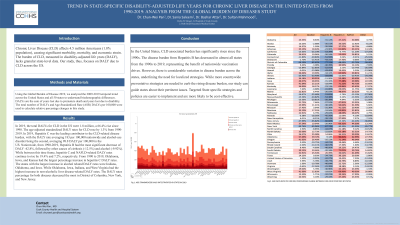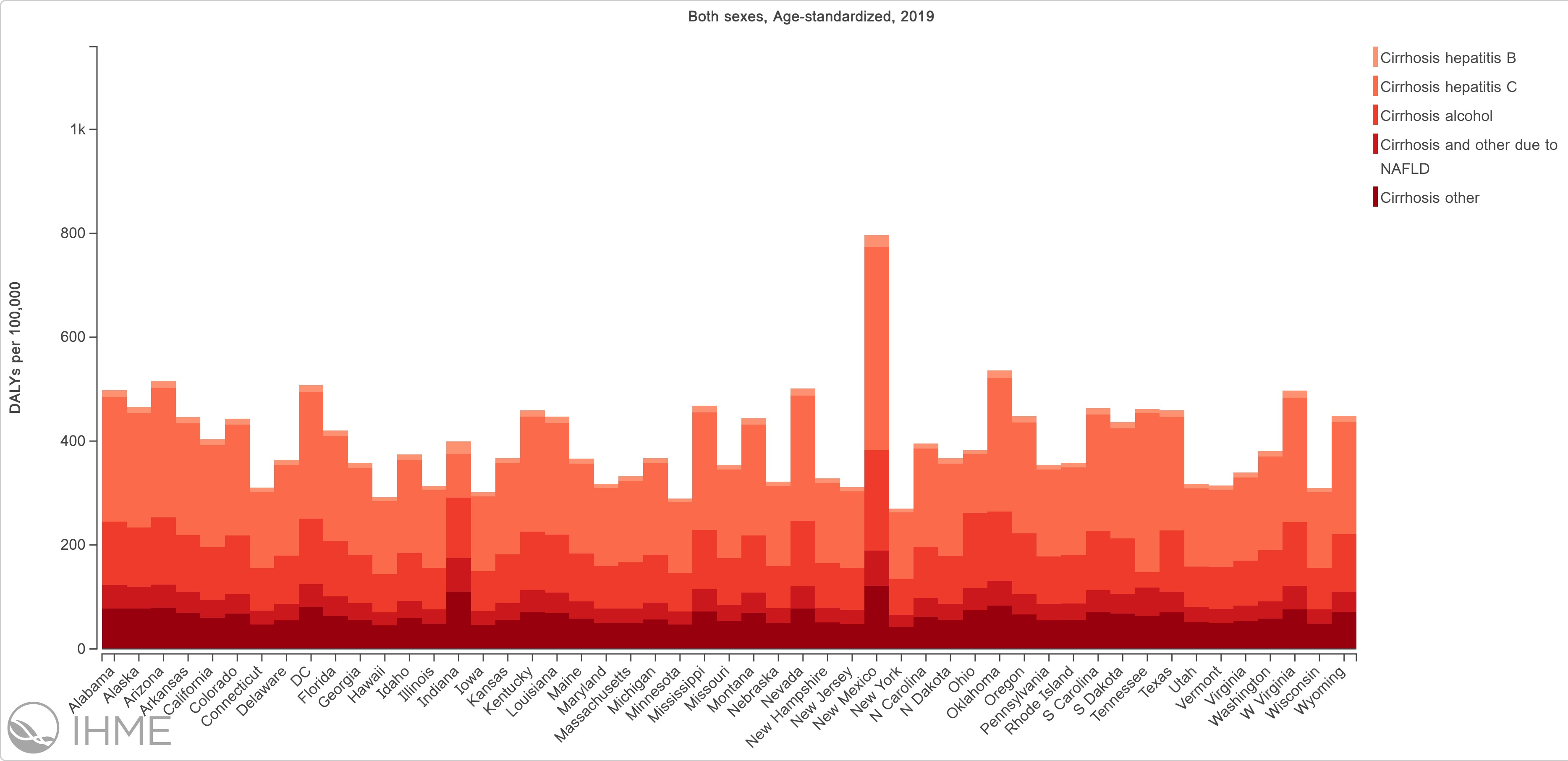Tuesday Poster Session
Category: Liver
P3768 - Trend in State-Specific Disability-Adjusted Life Years for Chronic Liver Disease in the United States from 1990-2019: Analysis from the Global Burden of Diseases Study
Tuesday, October 24, 2023
10:30 AM - 4:00 PM PT
Location: Exhibit Hall

- CP
Chun-Wei Pan, MD
John H. Stroger, Jr. Hospital of Cook County
Chicago, IL
Presenting Author(s)
Chun-Wei Pan, MD1, Sania Saleem, MD1, Bashar Attar, MD2, Sultan Mahmood, MD3
1John H. Stroger, Jr. Hospital of Cook County, Chicago, IL; 2Cook County Health, Chicago, IL; 3Beth Israel Deaconess Medical Center, Boston, MA
Introduction: Chronic Liver Disease (CLD) affects 4.5 million Americans (1.8% population), causing significant morbidity, mortality, and economic strain. The burden of CLD, measured in disability-adjusted life years (DALY), lacks granular state-level data. Our study, thus, focuses on DALY due to CLD across the US.
Methods: Using the Global Burden of Disease 2019, we analyzed the 2009-2019 temporal trend across the United States and all 50 states to understand biodemographic differences. DALYs are the sum of years lost due to premature death and years lost due to disability. The total number of DALYs and Age-Standardized Rate (ASR) DALYs per 100,000 were used to calculate relative percentage changes in this study.
Results: In 2019, the total DALYs for CLD in the US were 1.8 million, a 66.4% rise since 1990. The age-adjusted standardized DALY rates for CLD rose by 1.3% from 1990-2019. In 2019, Hepatitis C was the leading contributor to the CLD-related disease burden, with the DALY rate averaging 183 per 100,000 nationwide and alcohol-use disorder being the second, averaging 98.8 DALY per 100,000 in the US. Nationwide, from 1990-2019, Hepatitis B had the most significant decrease of DALY -42.8%, followed by other causes of cirrhosis (-12.5%) and alcohol (-9.92%). While between this time frame, hepatitis C and NAFLD-related DALY rates continue to rise by 19.4% and 7.2%, respectively. From 1990 to 2019, Oklahoma, Iowa, and Kansas had the largest percentage increase in hepatitis C DALY rates. The states with the largest increase in alcohol related DALY rates were Indiana, Oklahoma, and Iowa. While Oklahoma, Iowa, Indiana, and West Virginia had the highest increase in non-alcoholic liver disease-related DALY rates. The DALY rates percentage for both diseases decreased the most in District of Columbia, New York, and New Jersey.
Discussion: In the United States, CLD associated burden has significantly risen since the 1990s. The disease burden from Hepatitis B has decreased in almost all states from the 1990s to 2019, representing the benefit of nationwide vaccination drives. However, there is considerable variation in disease burden across the states, underlining the need for localized strategies. While more countrywide preventative strategies are needed to curb the rising disease burden, our study can guide states about their pertinent issues. Targeted State specific strategies and policies are easier to implement and are more likely to be cost-effective.

Disclosures:
Chun-Wei Pan, MD1, Sania Saleem, MD1, Bashar Attar, MD2, Sultan Mahmood, MD3. P3768 - Trend in State-Specific Disability-Adjusted Life Years for Chronic Liver Disease in the United States from 1990-2019: Analysis from the Global Burden of Diseases Study, ACG 2023 Annual Scientific Meeting Abstracts. Vancouver, BC, Canada: American College of Gastroenterology.
1John H. Stroger, Jr. Hospital of Cook County, Chicago, IL; 2Cook County Health, Chicago, IL; 3Beth Israel Deaconess Medical Center, Boston, MA
Introduction: Chronic Liver Disease (CLD) affects 4.5 million Americans (1.8% population), causing significant morbidity, mortality, and economic strain. The burden of CLD, measured in disability-adjusted life years (DALY), lacks granular state-level data. Our study, thus, focuses on DALY due to CLD across the US.
Methods: Using the Global Burden of Disease 2019, we analyzed the 2009-2019 temporal trend across the United States and all 50 states to understand biodemographic differences. DALYs are the sum of years lost due to premature death and years lost due to disability. The total number of DALYs and Age-Standardized Rate (ASR) DALYs per 100,000 were used to calculate relative percentage changes in this study.
Results: In 2019, the total DALYs for CLD in the US were 1.8 million, a 66.4% rise since 1990. The age-adjusted standardized DALY rates for CLD rose by 1.3% from 1990-2019. In 2019, Hepatitis C was the leading contributor to the CLD-related disease burden, with the DALY rate averaging 183 per 100,000 nationwide and alcohol-use disorder being the second, averaging 98.8 DALY per 100,000 in the US. Nationwide, from 1990-2019, Hepatitis B had the most significant decrease of DALY -42.8%, followed by other causes of cirrhosis (-12.5%) and alcohol (-9.92%). While between this time frame, hepatitis C and NAFLD-related DALY rates continue to rise by 19.4% and 7.2%, respectively. From 1990 to 2019, Oklahoma, Iowa, and Kansas had the largest percentage increase in hepatitis C DALY rates. The states with the largest increase in alcohol related DALY rates were Indiana, Oklahoma, and Iowa. While Oklahoma, Iowa, Indiana, and West Virginia had the highest increase in non-alcoholic liver disease-related DALY rates. The DALY rates percentage for both diseases decreased the most in District of Columbia, New York, and New Jersey.
Discussion: In the United States, CLD associated burden has significantly risen since the 1990s. The disease burden from Hepatitis B has decreased in almost all states from the 1990s to 2019, representing the benefit of nationwide vaccination drives. However, there is considerable variation in disease burden across the states, underlining the need for localized strategies. While more countrywide preventative strategies are needed to curb the rising disease burden, our study can guide states about their pertinent issues. Targeted State specific strategies and policies are easier to implement and are more likely to be cost-effective.

Figure: Age-Standardized DALYs Rate stratified by States in 2019
Disclosures:
Chun-Wei Pan indicated no relevant financial relationships.
Sania Saleem indicated no relevant financial relationships.
Bashar Attar indicated no relevant financial relationships.
Sultan Mahmood indicated no relevant financial relationships.
Chun-Wei Pan, MD1, Sania Saleem, MD1, Bashar Attar, MD2, Sultan Mahmood, MD3. P3768 - Trend in State-Specific Disability-Adjusted Life Years for Chronic Liver Disease in the United States from 1990-2019: Analysis from the Global Burden of Diseases Study, ACG 2023 Annual Scientific Meeting Abstracts. Vancouver, BC, Canada: American College of Gastroenterology.
